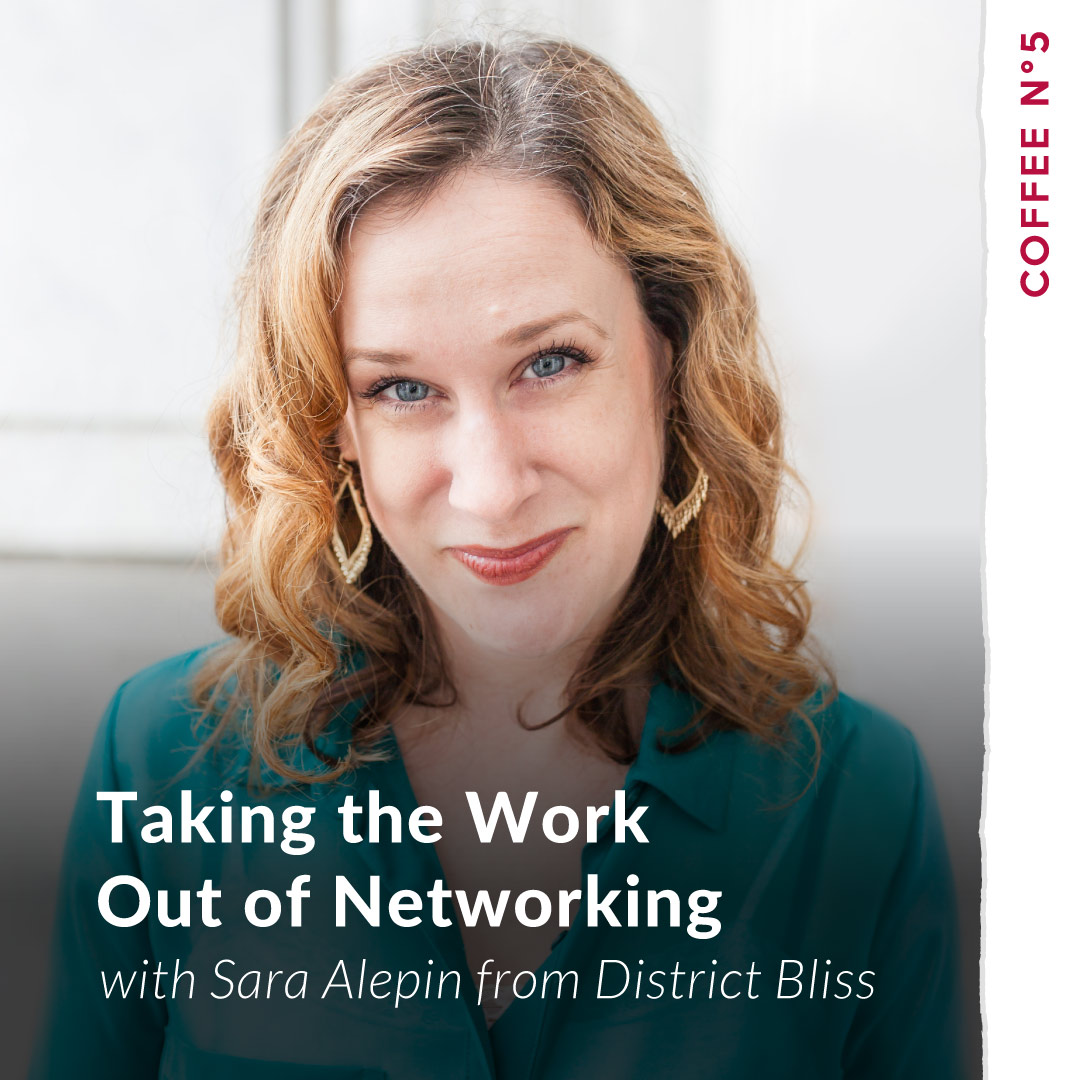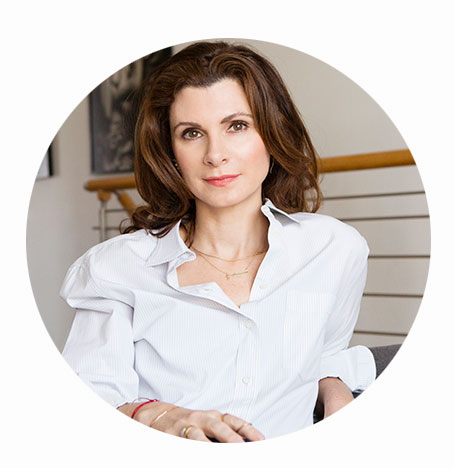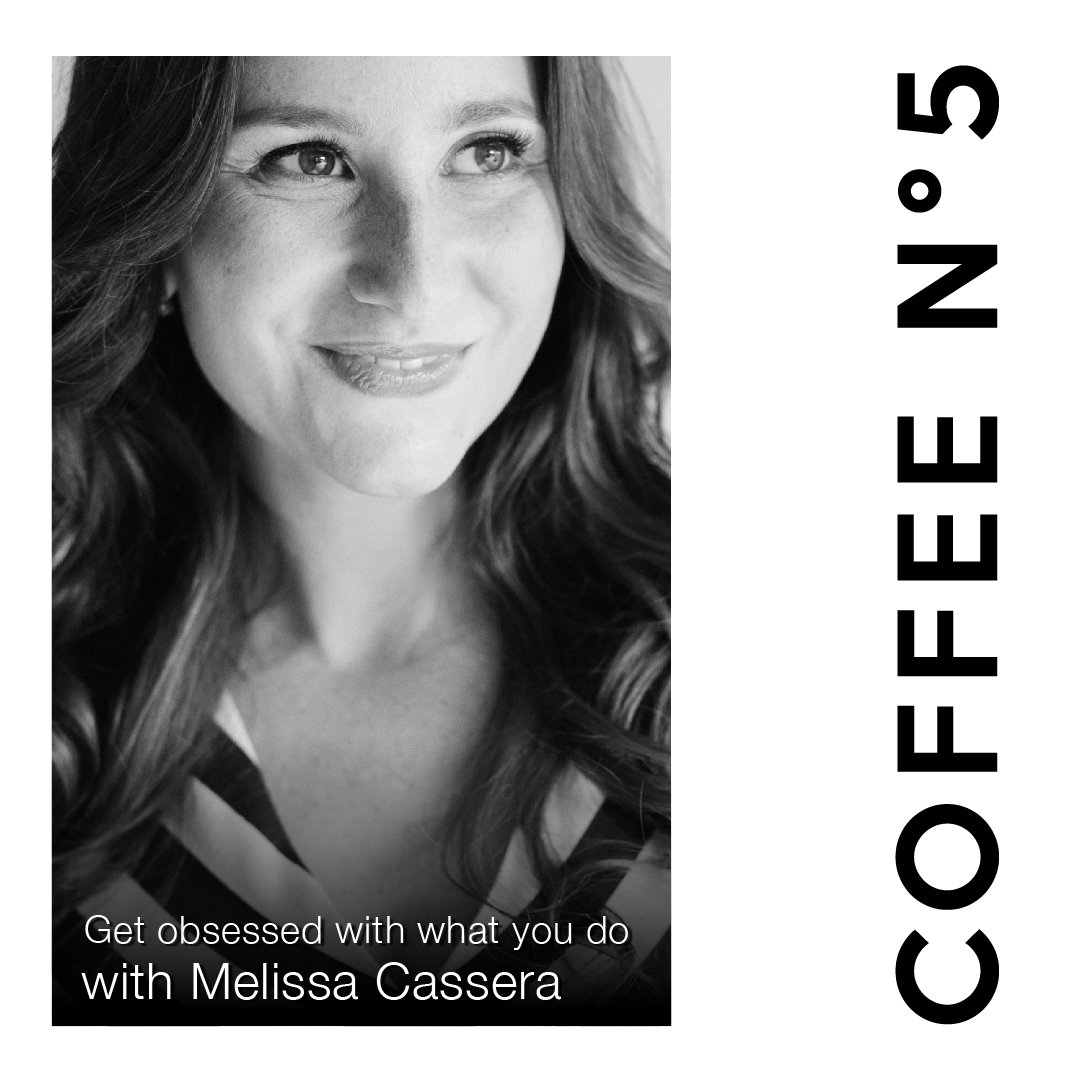Lara Schmoisman 0:05
This is Coffee Number Five. I’m your host, Lara Schmoisman. Hi, everyone. Welcome back to Coffee Number Five. My coffee is getting a little cold because our pre-podcast was a little longer today. And I mean, that’s why I love to do this podcast, I get to talk to the most amazing people out there that I don’t know if our path will cross otherwise. So today, I’m honored to have Vera Koch with us. Welcome -, how are you?
Vera Koch 0:43
Doing very well, excited to be here today.
Lara Schmoisman 0:46
And well, I’m so excited because we’re gonna be talking about one of my favorite things that it’s called Marketing. And I really was following your trajectory. And the companies that you’ve been in, and you were working always kind of with startups. So means that you have to be working with lean budgets most of the time, what does that mean? And what’s your passion that you start working with companies that, okay, I really want to make it or not that, because it’s starting up a company and just getting on board with the company with limited funding, is always a risk.
Vera Koch 1:26
Certainly, yeah. So as part of my journey there, I started very, I started my career with L’Oreal. So very large corporation then moved to Henkel beauty care, which is a very like, think of it as a German version of approximately I’m like, is a very large organization. And so while I was working in the large teams, I was realizing, the more I had the opportunity as Henkel was acquiring different startups that were all successfully funded and had grown to brands and companies of significant scale, like in my role here in the US, as Director of regional marketing, I had the opportunity to get to know successful founders, successful marketing teams, and learn from their journeys. And that really sparked my excitement and interest for smaller organizations, and scaling, scaling smaller brands to a successful level. And so it really was the entrepreneurial element that excites me the opportunity to start something new and be super fast, agile test trial, like but fail fast and move on to scale. versus being in a large organization, let’s say with, you know, what often comes with that is, you know, more corporate layers, you know, and less of a personal impact. Whereas in a startup environment, of course, everyone is has to be super hands on. And so always keeping in mind the bigger goal, the company’s strategy, but at the same time taking all the steps it takes to accomplish it. So yeah, so that’s always fascinated me
Lara Schmoisman 2:54
That’s very interesting, because when you have the background of big corporations is very different. When you start working with a startup startup that in a big component Corporation, every person has a role, when you start doing a startup, you need to do a little bit of everything, how was for you to, to do the switch from having your specific tasks to be to have to do a little bit of everything, and day basis?
Vera Koch 3:22
Yeah, I personally really enjoy it. Also, as marketers, especially in current times, things just the rate of change is so fast that I would feel for me personally being stuck in one area specifically would put me at risk of missing other skills that I also need to learn and adapt to. So this Starbound environment really challenges me to be at least to master many different areas from digital social content creation, CRM, performance, marketing, you know, so many different aspects where if I was in a large organization, and I could only be practicing one of those areas, I’d be concerned that I would just kind of miss the mark and miss the trends and other fields,
Lara Schmoisman 4:07
I totally get it. And that’s why I created my agency to be able to offer that to multiple clients and startups or smaller companies, because there is something to be said about integrated marketing. And it’s not the performance marketing anymore, because it for a few years, I believe that everything was performance, performance, performance, and they are all people who believe in brand and in branding, branding, branding, I think we need maybe levers that we need to integrate. Because really you can add layers of complexity by combining social with media by and with SEO and everything interconnected.
Vera Koch 4:52
Yes, I could not agree with you more. We can call it integrated marketing, performance-based branding performance and brands have to go hand in hand in today’s world, especially in the direct-to-consumer world. And what I love about it and what fascinates me is that, you know, when I think of my first days, my career we spent all this time in focus groups like getting eight consumers together to give personal opinions, things like that. Whereas today, with you know, clickers on impressions, we get feedback, brutally honest feedback from customers. And we have it at the at our fingertips. And so it is incredibly helpful. And in at Happy Head, for example, we are really building our brand based on this customer feedback, really trying to meet our customers where they are at the moment of their decision making at the moment of their purchase, and at the places for a little kid to educate themselves on in our case, heavy head serves the strongest and available hair loss medicine in the market.
Lara Schmoisman 5:51
So you have another layer of complexity here that is working with an FDA-approved job product, who are you before it was approved? Were you in that process?
Vera Koch 6:04
So yeah, good, good point that you’re mentioning that. So what we do is a dermatologist prescribed custom hair loss medicine with FDA-approved ingredients. So the way it works is that our customers, go through a questionnaire on our homepage, then upload a picture, and then talk to one of our licensed dermatologists to get their custom prescription shipped to their home. And what’s exciting about that is to know is that dermatologists are really the best to treat hair loss because they go through extra four years of education and training to make the appropriate prescription for you. This allows us to prescribe FDA-approved ingredients at a high concentration, a lot higher than most of what’s available in OTC and it leads to very successful results. So I always speaking of marketing, I have to mention to people that the before and afters on our homepage are real, they’re not photoshopped. Yeah, because it’s really rewarding to see ultimately, the thank you notes from customers who have gotten their hair back, and are so thankful and hence also loyal to our brand. So as the marketing channel, word of mouth is getting more and more important to us, because we have so many happy customers. But then going back through the journey, so that is we have FDA-approved ingredients. And again, it comes with a consultation from the dermatologist who is licensed in your state to give you what’s right for you and for to treat your health issues.
Lara Schmoisman 7:41
And that also says set up having a dermatologist license in your state. It’s a hell of a work from the back end.
Vera Koch 7:51
And yes, yes, I will give all the credit to our amazing founders and our phenomenal head of operations and Head of Product who are managing this piece of our business because yes, it requires a lot of perfection precision. And we take that very seriously, since it is teledermatology.
Lara Schmoisman 8:14
It’s something that it’s very attractive to me to work with us startups are smaller business and is the always don’t have the the availability of that amazing budget that you will have in a big corporation. So you really need to work lean. And I believe in working lean with strategy. But you have to plan and you need to how to use your budget money the most efficient way? How do you plan your strategy, given the budget that you have?
Vera Koch 8:49
Well, there’s goals, there’s a strategy that leads us there, which is overall we are, we are and when we first started on with it, we want to be the leader. Now we are the leader in dermatologist prescribe custom hair loss medication. And in order to build that out and grow to that goal, we are very metrics-based data-obsessed is how you could call it as well. So we have a foundation of a customer journey that functions for us. And we’re constantly working to optimize it. So then as we’re thinking about assigning budgets, we’re really carefully measuring the return on investment on all the moves we make. And it’s probably pretty common. I’ve definitely had that in other organizations to where I recall, in my Schwarzkopf professional days, we had set aside a budget of 10% for tests, ideas, innovation, trying something different and so same for us. We have We know what works well and we’re continuing to optimize and then we’re dedicating small tests pockets for additional marketing channels, ideas ventures, to make sure that we continuously expand But we’re careful not to spread ourselves too thin to make sure that we can really. And always check what scalable one thing is testing something that’s fine and cute. But if it’s not scalable, then what are we tested for? Right?
Lara Schmoisman 10:16
So what will happen? Like, for example, you say that you do any innovation and you try and things, how much time you give it to see if it works. And if it doesn’t, he will say, I’m not doing this anymore.
Vera Koch 10:28
Yeah. So when we talk about innovation, for product innovation, I think we have not even reached a point where we have fully explored and really leveraged every single innovation that we have in our portfolio to the fullest potential. But when it comes to other innovation, when I would say four ads that we run on meta, they get a solid week, and then it’s moving on. So it’s really, or same year are like always be testing email campaigns, this columns and people that are people, not people, sorry, like ads or ideas might get a second chance to test once more to see if there wasn’t another factor. But if something that we even though we all creatively, maybe enjoyed it. If it’s did not perform, then we understand that this is not what led the customer to convert interest or product.
Lara Schmoisman 11:22
So I see like, for example, going to Happy Head or website, they see that you guys have a very aggressive opinion of a six 60% of our and this is a risky move, because in this new first treatment that I think it lasts 30 days, right? They will they will receive more disturbing results in 30 days after using treatment or they will have to continue.
Vera Koch 11:50
Yes, yes to both. So the 60% off, I agree is a bold offer. What leads us to be so generous with the offer is that when people subscribe, we see a very high loyalty because there’s a very high customer satisfaction. That being said, it does take three to six months on average for the products to show results. Some people are seeing results a little bit earlier, of course that goes into our favor. But it also makes a difference once people have agreed to test our product. That they are that they then become part of our customer journey overall, in terms of the product they receive the information they receive.
Lara Schmoisman 12:33
You know, how do you bridge that gap? Because if you said that they’re gonna get a discount for the first 30 days, and they don’t see the results. How do you keep that retention on this second and third month until they start seeing results.
Vera Koch 12:50
A very big aspect of that is educating our customers around hair loss and the necessity for them to stay with the product a little bit longer to see the results. So when we think of brand archetypes and communication, we are noticing when we are interacting with our customers and also in terms of engagement rates, and responses that kind of a sage archetype kind of effect like informative, trustworthy effect-based communication is very helpful. Because a lot of customers come to us already with quite some knowledge about hair loss, a lot of customers fail up to Happy Head because they’ve tried other options that looked bright, shiny, easy to purchase, but have not worked at all. And so they’ve started to research and learn more about what ingredients are effective, and what treatment methods are good options. And so often they come already to us after they’ve seen what we’re offering realizing, oh, I can get to test drive finasteride. For example, at a high concentration prescribed by a dermatologist, those are all checkboxes that completes and builds trust for the customers and then need to know loyalty. And we do need them to trust us that our product is going to show results in three to six hours. So goes back to communication.
Lara Schmoisman 14:17
Yeah, but what are the tools that you find more? Sorry, I forgot what it is. Don’t worry about it. No worries. So sorry about that. What are the tools that you feel more efficient? At the time of communicating these messages were are because there’s so many tools out there and so many programs now with AI and by cell on TV and cell live online? What are the tools that you found that were more effective communicating your message and getting return of investment? Are you speaking to the very first touch point or in last retention or would you like to Say,
Lara Schmoisman 15:00
all of them. And all of them.
Vera Koch 15:04
Absolutely, yeah. So for us, made on Google are very not a surprise for direct-to-consumer companies, that those are very important platforms for us. When it comes to ADS, always test we launch 40 to 60 ads a week to ensure messaging is relevant and to ensure that we constantly optimize, and is part of that journey.
Lara Schmoisman 15:29
That’s something that I always say it’s key. It’s optimizing and optimizing and optimize it, because that makes us understand also our customer, when we understand what keywords by what keywords, people find us. We are learning a little more about our customer.
Vera Koch 15:47
Yes, exactly. Absolutely correct. So those work really well for us. And then also not a surprise, on the retention element, it is really email our CRM, we have an amazing director of CRM, who is leading, leading this piece of the puzzle for us. And so that’s a big element as well as also inbox communication. So as people receive their shipment, they receive communication that educates them around the product as well and gives words of affirmation and encouragement.
Lara Schmoisman 16:20
They besides that package that they receive with the product that you guys do it any kind of marketing that is not digital.
Vera Koch 16:28
I’m not really No, not yet. That could always change. But I think it leads back to a lean startup and being very mindful in how we’re spending our budgets right now. I think that outdoor advertising, for example, could work phenomenal for us. But ROI is hard to measure. Actually, there is one thing, there’s a truck driving around LA design on it’s super fun. People texts us all the time that they’ve seen a truck and are excited about it. But the truck has a QR code on a dedicated landing page. And I will just say, we’re not seeing the same conversions as we’re seeing elsewhere. So it’s kind of hard sometimes people will say like, Oh, I hope that this campaign is gonna work and I hope we’re gonna notice something but I just don’t love building business on hope.
Lara Schmoisman 17:17
Yeah, well, I mean, this is a sensitive subject, like a lot of things in wellness and it also is challenged to find someone like many beauty brands can do give them that it’s an easy one. But not a lot of people can give you a want to give you a content about the subjects.
Vera Koch 17:36
Yes, that is correct. And especially with FDA-approved ingredients, there is no we can absolutely not gift the product that it has to be prescribed. So we have a few supporting products like shampoo, conditioner supplements and, and a derma roller that we can use for gifting just to tease the brand via the tour effect and the true center it does take especially for our like ambassadors influencers which we have a fuel for them to really be you know, struggling with hair loss receiving
Lara Schmoisman 18:07
always do what’s in negotiation to find the those influencers or ambassadors that they are interested in, or they’re okay of talking about their journey.
Vera Koch 18:21
A lot of word of mouth and just networking or our own customers reaching out to us. And then, you know, picking up the conversation, they’re definitely different from other Ambassador types or campaigns that you can launch where, you know, lipstick, for example, right instant gratification really easy to tell the story in a video. Uh huh. Yeah, but that would summarize it probably. And then we have a few other campaigns running where we’ve had people like, dim or you know, our shampoos, but it’s just not the same because our core of the business is somewhere else. So less is more, I would say though, if you have a few good ones who tell the story very well, it might just be a lot more impactful than spreading yourself super wide. And then you have, you know, I’d rather take 10 really strong pieces of content, then 100, medium mediocre ones.
Lara Schmoisman 19:16
In your case, also you have two very powerful doctors, we who are the face of the business. So by finding an influencer or a personality behind the brand, you will be competing with the authority of the doctors for the brand.
Vera Koch 19:36
Yes, that could definitely be a risk that we could have. So we actually in our situation, we have the doctors, of course as our strongest ambassadors and influencers. They also are very well known in the space. Dr. Shawn was just nominated as one of the top 10 head transplant surgeons well worldwide so they have a really good following and they are really strong, trustworthy content. craters themselves on YouTube, TikTok, and Instagram. But then the other ambassadors for a brand are either patients who have seen results the before and afters. Or we have also worked with a few dermatologists as well as ambassadors to speak to hair loss in general. But we definitely I would definitely say they’re different to us in terms of the importance of our founders, as spokespeople for our business overall, then dermatologists sharing the information about our brand and our benefits from a doctor’s perspective. And then customers showing the results as a very impactful way, but not taking the stance of educating on hairless itself. But more while I’m so impressed, like see my before and after, and then telling about the emotions and their own experience with the product.
Lara Schmoisman 20:55
I mean, there’s I mean, my mind is blowing here because I have some so many thoughts in this space, because it’s wellness. It’s really, it’s medical, you have so many different ingredients here in our Thank you like, for example, what is going to be your email segmentation? Because you have different issues to assess in your email segmentations Do you have tons of groups or users send content to informative content to everyone.
Vera Koch 21:30
So we don’t segment our email database by like, because we have to be very thoughtful with patient data because of HIPAA compliance. So there’s not a place where we would see what like for us as the marketers we don’t see or we would not be able to leverage. The reason why someone’s losing their hair, we do not have that information. So our email segmentation is really male, female, can be location based can be based on past orders based but overall, when we’re looking at our content, we in our blog, and in our emails, newsletters, we educate on general topics around hair loss, we use a lot of the questions that people have posed to us either to customer service or via social media like should it can I wear a hat? How about hair loss on the summer? What can I put on my scalp in terms of sunscreen or so there are a lot of other general topics surrounding hair loss that are that engage our audience. So with the engagement, we’re assuming it’s really interesting for our audience, but this is how we’re building the content in that way. So it’s a lot more universal.
Lara Schmoisman 22:40
Absolutely. If you will have all the budget on a limited budget, what would you do for everyone like Happy Head
Vera Koch 22:48
I would love to expand to more channels. That is something where I think there’s I would see a lot of opportunity expanding and testing more channels, if I had more budget. For example, probably the next thing I would do saying, for you know, we are, we are to a certain extent, we’re present on YouTube, Tik Tok Pinterest, but not to a scale that other brands are present. So that’s something I would love to do more. And then I think overall content creation is a lot of work when it’s done in-house with a small, scrappy team. So it will be phenomenal to have you know, the luxury of a big producing agency and just make a wish list and then see the results and approve them. Right now. We’re super hands-on doing that ourselves. And I really enjoy it. It’s something that I really love about my work. But yeah, so those will be probably the first things and then of course, things like, you know, streaming, outdoor advertising, all of these would be phenomenal additional things to do all but you know, just being thought, as we’re scaling thoughtfully. It also only makes sense to enter those challenges properly when there is a certain budget available.
Lara Schmoisman 24:09
Yeah, I think that’s the beauty when you work with a strategy that EEO is what I call sustainable strategies that you create a strategy that you can sustain in certain amount of time. I seen so many companies and they have this budget and to burn everything in us. And then they don’t realize that the product will take time for brand awareness that it’s not gonna be an overnight success.
Vera Koch 24:37
Yes, I agree with you.
Lara Schmoisman 24:40
Since from the beginning of your journey, when do you start? How much time do you give to a brand for brand awareness? When you start playing your I’m sorry, when you started something new.
Vera Koch 24:58
That’s it Good question.
Lara Schmoisman 25:03
And I know that it’s not there is no easy answer, because each product is different and depends on many factors. I’m a believer that if you believe in the brand, you need to keep going, even if it’s a little bit at a time, and you’re gonna grow a little bit at a time.
Vera Koch 25:18
Yes, I agree with you really depends, I would I agree that it depends really on the product, the segment the marketplace. I mean, if it was something very trendy, I wouldn’t give it a long time to, because it also depends on how competitive the spaces that you’re in, and how fast that space moves on. So I would definitely apply different rules for a trending makeup item, or a lather like a fashion item they can get so seasonal versus something like hair loss, where teledermatology we know, overall, telemedicine is just showing steady growth. And so in our case, as we’re looking at long-term and sustainable growth, I would definitely give our brand more brand for awareness, more time for awareness, as we’re building study. But I would also say that large budget and brand awareness go hand in hand. So if you’re the shining star that’s going to be gone in a year, then you need a lot of money to make that work.
Lara Schmoisman 26:23
Absolutely. Absolutely. I think brand awareness. Sometimes you have the luck factor that something happened, but you cannot count on that.
Vera Koch 26:32
No. Yeah, the magic. Oh, yeah. Let’s just Let’s just go viral. thing every market. I think there’s so many marketing news, right? Oh, yeah, just go viral.
Lara Schmoisman 26:42
Right. Exactly. For me, when someone tells me, let’s go viral is okay. And let’s lighting candles, maybe just in case, the exact dancing boy trials, because usually, there is no magic recipe for that.
Vera Koch 26:59
Yeah. And I think a lot of brands that have gone viral or have gone viral on, you know, a $3 million influencer budget.
Lara Schmoisman 27:11
So there’s something to be said about going viral like at some times it happen. And the companies are not clear to the labor. Yeah. To go when you go via Yeah, like, for example, in your case that everything is prescribed and need to be going through a doctor there is I mean, you cannot go right out with something like this. Unless you go to not even not a pharmacy, you need to go to doctor offices.
Vera Koch 27:41
No, yeah, for our product, it really just it’s really designed to be online. So people do all their interactions with a dermatologist online. So there are no plans for happy had to be for the prescription strength to be sold. In the pharmacy, it kind of would make sense to kind of what would kill our unique selling proposition. Because you’re getting it from the comfort of your home talking out of a topic that you may not be comfortable about from the comfort of your home, getting it shipped to your door without having to even show that you’re buying this type of medication that has has a lot of benefits to it. I could see us at some point maybe have like surrounding supporting items retailed somewhere, but this goes back to what do you do when you have a limited budget limited resources, it’s about staying focused, and leveraging your strength when you’re trying to play everywhere or when you’re trying to be everyone and everything to everyone else, then it’s just stretches you’re really thin.
Lara Schmoisman 28:41
Thank you so much for being here. I really really appreciate that talk and all your insights and I found it fascinating to be to learn from each company from inside the company because sometimes we will only see the success stories or we see just one part of the story.
Vera Koch 29:02
Thank you so much for having me. I really enjoyed our conversation.
Lara Schmoisman 29:07
And to you guys, I will see you next week with more Coffee Number Five. Find everything you need at LaraSchmoisman.com Or in the Episode Notes right below. Don’t forget to subscribe. It was so good to have you here today. See you next time catch you on the flip side. Ciao ciao.








